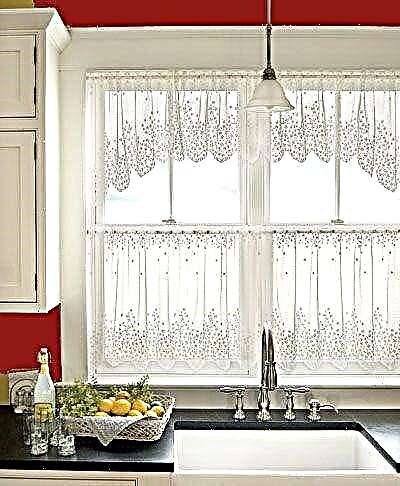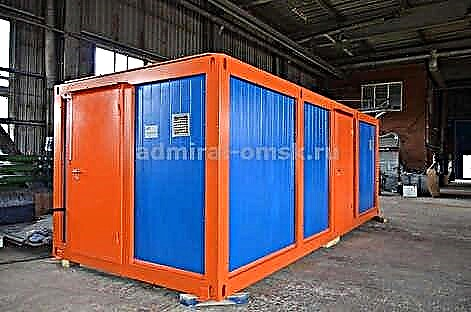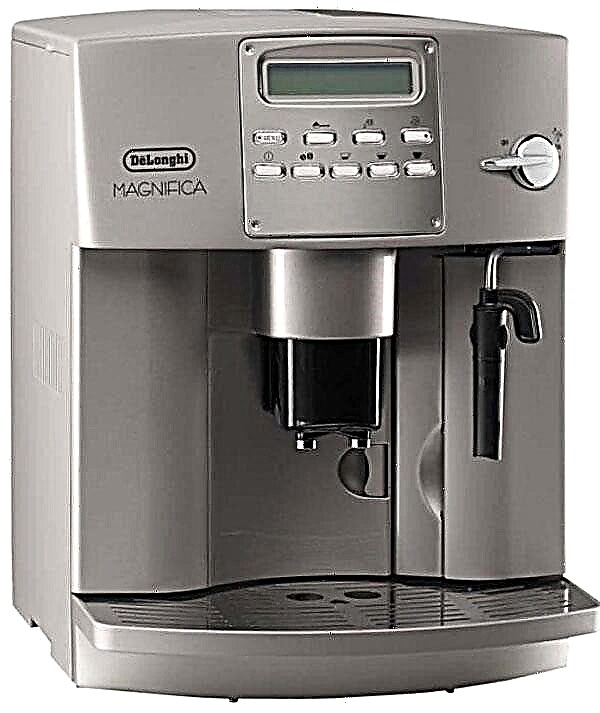The most convenient, probably, a device for storing things is a dressing room. Indeed, it’s really cool when all the details of the wardrobe are in one place and you can immediately assess how well the kit you just selected is combined, and not run from room to room - take it, try it on, see it. Moreover, you can make a dressing room on a very small area: the minimum is 1.5-2 square meters. Even in a small apartment, it is possible to block such a space. Moreover, it was noted that it is more convenient to use them if the dressing room is assembled with your own hands. It's simple: no one knows your habits better than you and will not be able to arrange things in the right order. So, we proceed to the independent creation of the wardrobe room.
Wardrobe sizes
Our realities are such that most of the people live in small-sized apartments, where every centimeter counts. Because size issues often have a decisive role. The smallest dressing room can have an area of 1.2 - 1.5 square meters. meter. This is a rectangle with sides 1.5 * 1 meter or so. Also, a small dressing room can be angular - this option is even more capacious than a rectangular one with a similar area: with an equal area, the length of the sides along which you can arrange shelves and storage systems will be greater.
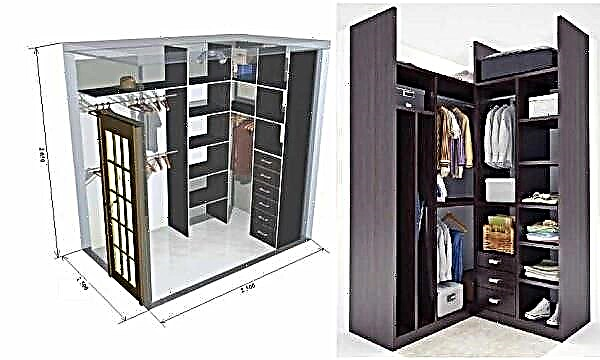
The smallest walk-in closets: 1.5 by 2.5 m and 2 by 2 m
A rectangular mini-wardrobe room with one-sided placement of things should have a width of at least 1.2 m, with a bilateral - at least 1.5 m. The depth should be such that it was possible to "enter" there. This closets, in general, differ from the closets, and also - the ability to install any doors.
Ventilation and lighting
Even in mini-walk-in closets, and even more so in large ones, ventilation is needed: in a closed room a smell of musty quickly appears, which no perfume will mask. Therefore, even when planning, find a way to make ventilation in the dressing room.
The principle of its arrangement is no different: in the upper part of any wall, preferably further from the door, an exhaust hole is made where the fan is inserted. Inflow is provided either in the slot under the doors or in special air inlets located just above the floor level. They are closed with decorative grilles. Ventakanal output should be in the general ventilation system, you can use plastic boxes to bring it out onto the street or under the roof of a private house. Organized in this way, air exchange effectively maintains the normal state of things.

Principles of organizing ventilation of the dressing room through the bathroom
When choosing a fan, you should pay particular attention to the noise level. Since dressing rooms are often made in or near bedrooms, noise should be kept to a minimum. It can be controlled by automation or turned on / off by conventional or continuous switches.
Lighting should be bright. Firstly, it is necessary to quickly find things, and secondly, wardrobe rooms are often used as dressing rooms to immediately see how selected items fit together. In this case, the mirror is usually placed on the door or mirror doors are made. In this case, the light should be directed not only to the shelves and storage systems, but also to the fitting zone.

One of the options for lighting
You can use any type of lamp, but it makes sense to make sure that they are turned on by motion sensors. They opened the doors - the lamps were lit, there was no movement, they turned off. There is another option for swing doors; there are lamps with buttons that light up when the door is opened and turn off when they are closed.
Where to do
Even in small apartments there are "appendicitis", which can not be used normally. It is in such a place that you can make a dressing room.
Another popular option is the pantry. In this case, everything is generally simple. Remove all unnecessary, change the doors and set the appropriate content: racks, racks, baskets, shelves.
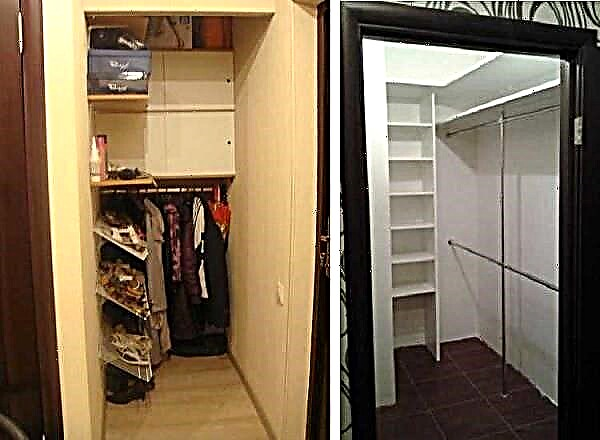
Wardrobe room from the pantry
If there is nothing like this in the apartment, part of the room is fenced off - end or corner - you need to look at the layout. The corner wardrobe room is good in that it allows you to use the most difficult to equip areas, namely corners. Especially if there are closely spaced doors in two adjacent walls. This zone is considered “dead”: you can’t put anything except a small corner shelf: everything will interfere. Approximately the same option - two windows or a window and doors.

Corner wardrobe room
If the area turns out to be too small, there is an opportunity to increase it a little, making the wall not even, but with the middle extended slightly. The area of the room from this will not greatly decrease, but things can fit much more.

A way to slightly increase the area
They also make them on the loggia - by making part of the glazing opaque or by building a wall. Only here you can not do without insulation - it is unpleasant to wear cold clothes in winter.
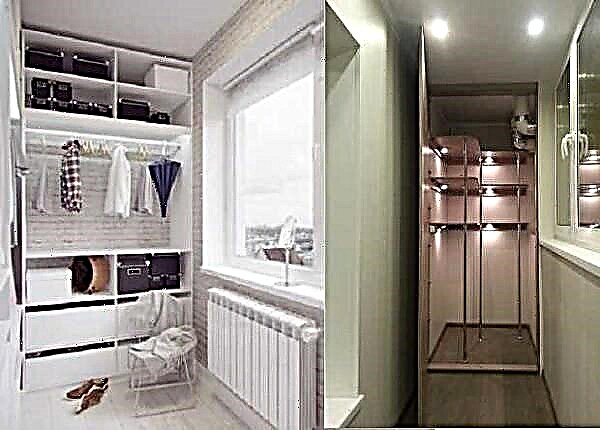
Dressing room at the end of the balcony or loggia
The second option is suitable for wide loggias. In them racks can be put along a long wall.

Use case for a balcony
In the corridor or hallway, too, they block a corner or “appendicitis”, if the layout allows. Here everyone can decide only according to the place: is there a place for this or not.
Most of all, the wardrobe is appropriate in the bedroom. Here is simply the best place to store things: in the sense - dressing here is more convenient. Therefore, for these purposes, part of the room is fenced off. In this case, a partition is necessary and most often it is made of drywall. This technology has long been known and worked out to the smallest detail. A lot of time even in the absence of experience will not take: a maximum of two to three days for assembly and decoration.
If you make a partition from GKL or GWP according to all the rules, you will need double cladding, and this is “eaten” centimeters, or even square meters. Therefore, most often they are sheathed only on the outside, but with two sheets with overlapping seams. When assembling the frame, do not forget to make reinforced racks for mounting the door. With a single sheathing, naked profiles remain inside, but it is convenient to hang basket baskets for things on them. If you plan to do so, then take them with a thick wall: to keep the weight normal.

Drywall partition for dressing room
The partition can also be made of laminated particleboard or OSB, MDF boards. This is an option for those who do not like to mess with putty. But you need to choose a lamination that will fit into the interior without any problems.
Doors for dressing room
What is good about a do-it-yourself dressing room is that you can put any doors: sliding, such as a “coupe”, accordion, ordinary swing doors, hinged on casters. You can even get by with the bases completely. This option is called a dressing room-rack, but then everything will have to be kept in perfect order: everything is in sight. The most budgetary option is blackout curtains or something like a Japanese curtain.

Installation options for sliding sliding doors
If the front wall is large, part of it may be stationary, part - occupied by doors. In this case, the stationary walls can also be used somehow. If desired, the doors can be made in full width, or consisting of fragments.
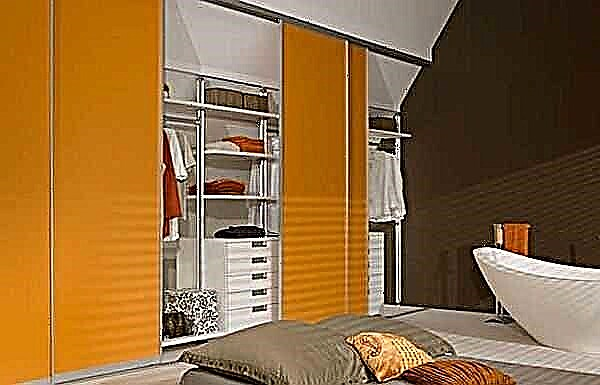
A wardrobe option in the attic: a side part with a low ceiling is occupied under it. Full-width doors - easier to get to things
The design can be anything, just to fit into the look of the room. If desired, they can be made to match the walls, so that it is not visible, but it can be bright and striking.
Arrangement: filling and storage systems
If the area is limited, there is no point in making wardrobe furniture made of wood, MDF or particleboard. They take away precious centimeters of the area, and even interfere with the movement of air. Another drawback is that redoing something is problematic.

Furniture of "standard" type takes up too much space
Recently, the general trend is the installation of light metal storage systems. They are modular, assembled on special racks. Racks can be attached in two ways - to the walls or to the ceiling and floor: different manufacturers make different systems. And already everything that is necessary is hung on these racks.
Racks can have notches along the entire length, which makes it possible to install any element at any height. These are the most mobile systems that can be modified easily and simply - simply outweighing from one row of notch hooks to another, changing arbitrarily the height of the shelves and baskets, other elements.

Convenient modular system
There are racks of rectangular section, with grooves cut from both sides. In these grooves, the necessary accessories are attached to the clamps.

A different type of struts and a different mounting system
Please note that shelves and drawers are different - from wood or wood materials, metal - chrome or painted. They can be retractable, they can be placed on top of one another or on shelves.
All of these systems are sold: racks and a list of different components. But they are produced mainly in European countries, because the price "bites". The economical version of the equipment for the dressing room can be made independently from a round chrome furniture pipe and various fasteners to it. It turns out this furniture is not as mobile as we would like, but it costs significantly less.

Dressing room equipment made of round furniture pipe
Clothing Accessories
In addition to standard and not very drawer shelves, there are interesting special options. For example - skirts or scissors. Special guides on which the transverse bars are fixed, sometimes there are clips on them. They allow you to hang skirts / pants evenly and not be afraid that they will fall. It is convenient if such a hanger extends, allowing you to inspect all the contents.

One of the options for filling the dressing room is the bracket for skirts or trousers
This device can be replaced by a simpler, but costing several times cheaper - a hanger with crossbars located one below the other. This is not so convenient, but it allows you to arrange clothes no worse.

Budget option of hangers for trousers and skirts
There is a retractable design for ties, only it is usually oriented differently and travels in length, although not everyone likes this system, but rather it is folded into the drawer cells to taste.
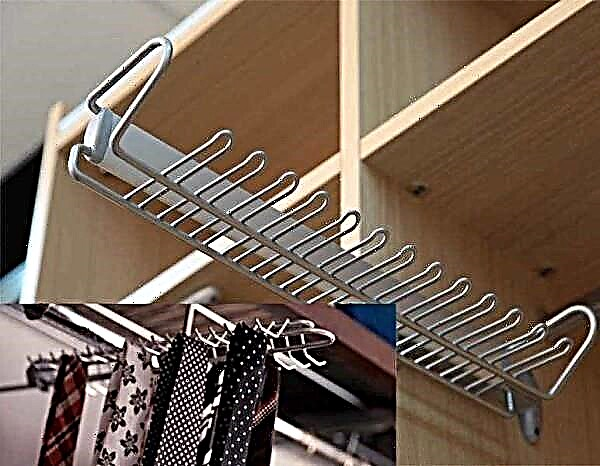
Tie Devices
There are several ways to place your hangers. The simplest is pipes, more economical (in terms of space utilization, but not in terms of money) - tie-like retractable brackets.

Extendable brackets for clothes hangers
Another device is a pantograph for clothes. This is also a pipe, but capable of dropping. A kind of elevator for clothes. Such a device allows you to use the space up to the ceiling, and not at the expense of your comfort. It can be attached both to the side walls (a more common version) and to the wall. In the middle of the pipe, a handle bar is attached, pulling by which you lower it to a horizontal position. The carrying capacity of such devices is usually small (up to 18 kilograms), therefore they are used for lightweight clothes.
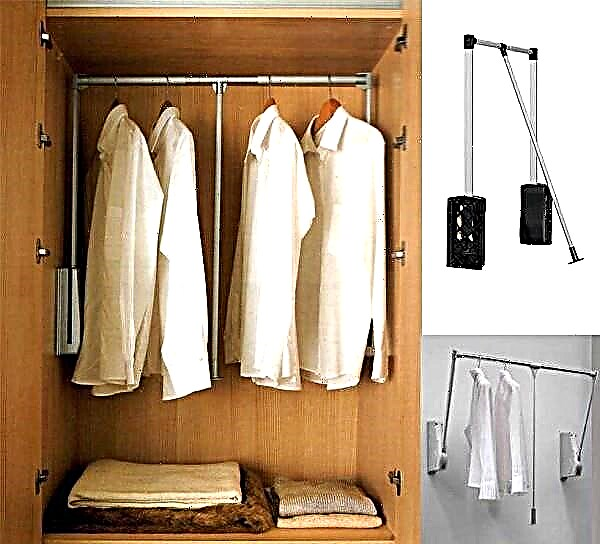
Furniture pantograph - for light (by weight) clothes
Shoe storage systems
Often there are problems with storing shoes: some have dozens of pairs, so it’s just right for them to arrange separate dressing rooms. But among the standard sets of equipment there are several interesting for storing shoes.
Let's start with the retractable system. She is in IKEA. Pins with shoe modules mounted on a movable frame. Convenient, compact.
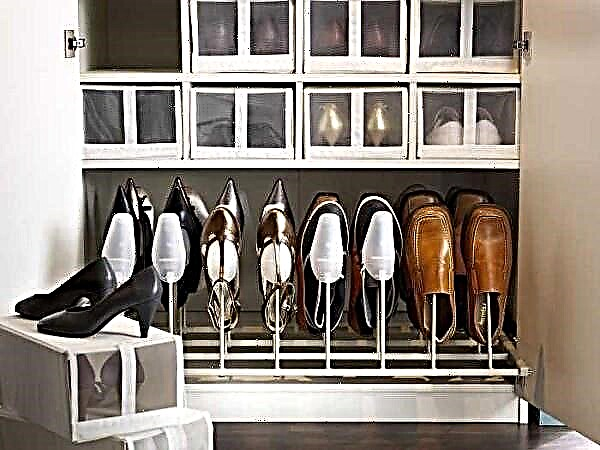
Retractable shoe system
There are mini-chests of drawers that do not take up almost a place, but are hung on the walls, there are hanging organizers that are easy to place on a horizontal pipe.

Shoe storage systems in the dressing room
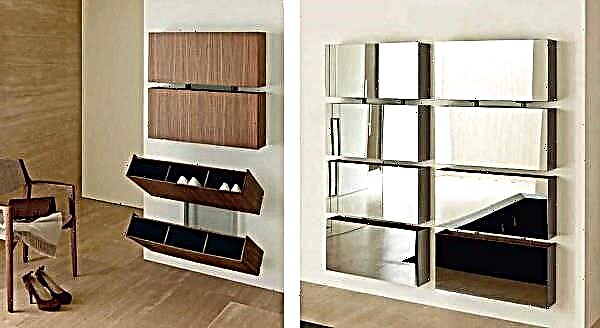
This is a mini wall dresser
In general, for shoes there are many interesting ideas that allow you to place it compactly and at the same time conveniently. Some are in the photo gallery.
There are very inexpensive options. For example, seasonal, the one that is currently used, can be stored on a grid with rearranged hooks or wire shelves. You’ve probably seen similar ones in stores. This is a mesh or perforated panel on which hooks / shelves are hung. Convenient: you can move under any type of pads, make more or less distance.

Economy option for storing shoes - mesh with hooks and shelves
Hanging such a net is not a problem - even on the wall, at least on the side of the cabinet or door. Hooks and shelves just cling to the crossbars. This option is ideal for a shortage of money and space. If you like the idea, but need something more presentable, make or find a perforated metal shield on the frame. Hooks are also inserted into it “with a bang”.
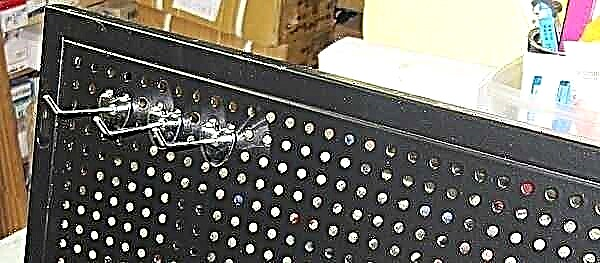
Modification - shield with hooks
In general, with the arrangement of the dressing room and a limited budget, it is worth looking for storage systems not in furniture stores - on-line or off-line. It is better to look at sites selling commercial equipment. There are many interesting devices that save space: shops also try to set maximum goods on a minimum area. For example, such shoe racks.

Stands for shoes
If you attach wheels to the first one, you get an excellent retractable system. The price of such equipment is much lower than the equivalent, but which is sold in furniture.
Making a dressing room project
The ideas of equipment and storage systems, as you see the mass. But so that it does not turn out that the purchased great item just does not get into your wardrobe, you need to draw a plan on which to indicate all dimensions and dimensions. It is drawn to scale, then mark on it those parts that must be necessary. They are drawn on the same scale. If everything “fits in”, armed with dimensions (you have them, or you can measure in the figure and use the scale to calculate the real values), you can go to the store to choose the system.
There is a different approach. You will find out the dimensions of the devices and systems you like (mounting dimensions), cut them to the scale of cardboard or thick paper, and try to combine everything. If it works out - fine, you can buy. No - look for other options. As a result of your efforts, you should get something like this layout as in the photo.

An example of the organization of space in the dressing room (indicating the minimum sizes for different types of clothes)
To make it convenient to use the equipment and get things, it is necessary to maintain the following distances:
- minimum distance from shelf to shelf:
- when storing things - 30 cm,
- when storing shoes (without hairpins) - 20 cm,
- shirts, jackets, jackets - 120 cm,
- trousers:
- folded in half - 100 cm,
- in length - 140 cm,
- compartment for outerwear - coat - 160-180 cm,
- under dresses - 150-180 cm.
At the very top, we allot space for clothes of another season or rarely used things. Often there is a place for a vacuum cleaner downstairs, and an integrated ironing board is made in one of the cabinets.
For those who like to work with their hands, there are several schemes with sizes so that you can equip your dressing room with your own hands (at least partially).

Drawing shoe shelves with dimensions

How to make shoe holders

System for storing shoes from plastic pipes ...
Where to begin?
We determine the workspace. To functionally place everything you need - 1.5-2 square meters is enough. meter.In a dwelling of any size, such a space can be allocated.
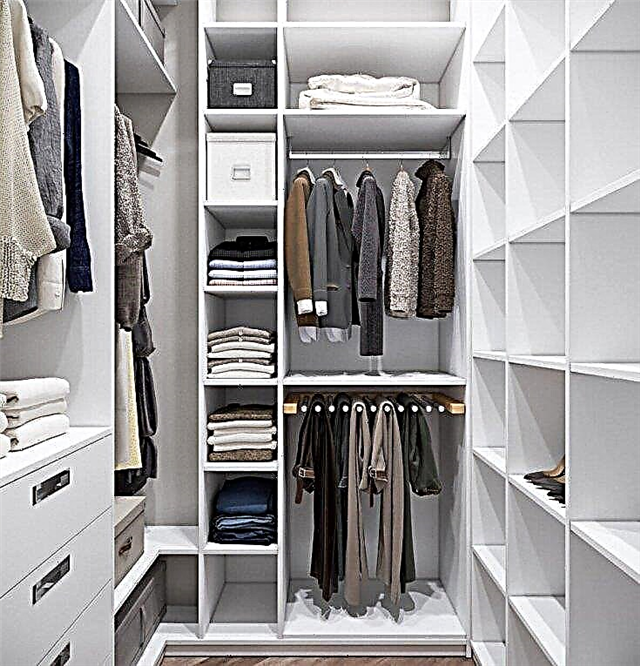
You need to determine exactly where the storage structure will be. It will be a bedroom, a closet, maybe a corner in the hallway or just part of a room.

Why do you think the prospect of collecting with your own hands is better than you, because there are many specialists who will quickly and efficiently do such a job.
This has its advantages, there is nothing to argue with, who knows your own habits better than you, where it will be better to hang and lie. Only self-assembly of the wardrobe room will help you quickly find everything you need, and will make the house cleaner.

So that the construction process does not drag on for years, consider everything in advance. On the Internet on this topic offers a lot of options.
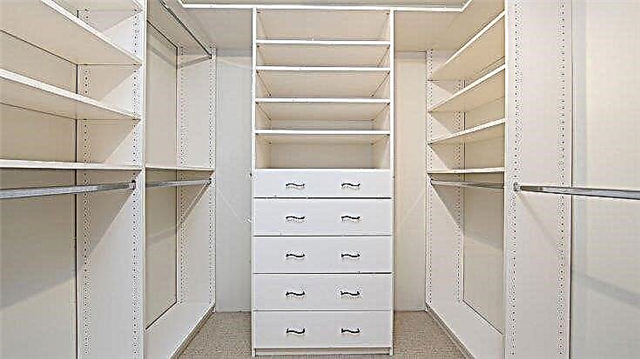
DIY ready-made wardrobe room photos, design projects, diagrams, drawings will become a good example and will help you navigate in further actions.

Take a look here!


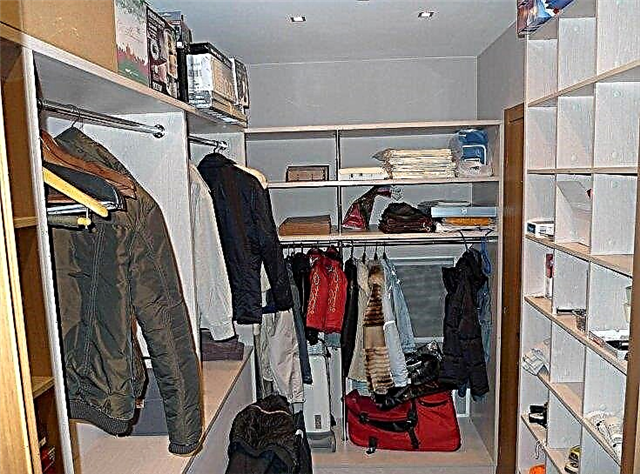
The ventilation device is no different from any other ventilation. Under the ceiling (no matter what wall), an exhaust hole breaks into where the fan is mounted.

Air enters either through the slot under the doors or through special air inlets that make it a little higher than the floor level. You can close them with decorative grilles.

Air is discharged into the finished ventilation, if it is already there, if not, a separate outlet is mounted. The presence of fresh air allows things to remain odorless, freshness remains after washing.

Pay attention to the noise level of the fan, since often there are dressing rooms in the bedrooms, a noisy fan will bring you discomfort.

The project of the corner dressing room in the hallway
In all houses, apartments there are places for which it is usually difficult to come up with a destination. This space is quite suitable for our task.

There are two ways to divide the area. A partition is the first way, this option is suitable only for owners of a large room. When space is at a minimum, an open storage system will do.

An elementary solution, just a corner cabinet filled with a convenient storage system.

With any option, it is recommended that the racks and shelves be left open, which will save space. It is worth saving so that there is a place for passage, and the ability to dress inside.
Installation of the wardrobe room in the bedroom
Literally every American TV series dictates the style of the future bedroom. Wardrobe in the bedroom is the dream of every woman, without exception. It can be in the form of the letter "P" or "G".
But, of course, the first option is a classic. Large bright room, a mirror throughout the wall. A room in which you can show off in a new dress, immediately try on boots or a coat to it.

The key to success of such dressing rooms is proper lighting, of course, if the size of the room allows. Shelves and rods for hangers can be installed on all three walls, which is very convenient during operation.

You can install hidden shelves to store some things for everyday use. Ironing board or dryer is convenient to fit behind vertical shelves.

Storeroom as a wardrobe
First of all, examine the dimensions of your pantry, whether the space allows you to make a dressing room from the pantry with your own hands.

The requirements are quite simple, almost any pantry will do. For the device of hangers, shelves and drawers, a meter and a half is enough.

Placement of shelves on only one side of the dressing room, implies a width of 1.2 meters. If the shelves are arranged on both sides - from 1.5 meters.

In a small dressing room with your own hands, it is better to distribute all the drawers in the lower part, at a distance of up to 120 cm from the floor, so that you can see what lies in them.

For everyday things (shirts, trousers, jackets, blouses), a height of 90-100 cm is enough, you can also design two floors, one above the other.

To hang, for example, a coat or dress on the floor, you need to have a vertical of at least 150 cm. The rods for such things can be placed both on top and leaving space under the shelf.
Do-it-yourself wardrobe from plasterboard
- First you need to do purchase of building materials and tools.
- Decide on the location dressing room.
- To develop a project. It is not enough just to draw a diagram or sketch, you also need to make markings on the walls, floor, ceiling. Browse catalogs, various photos on the Internet.
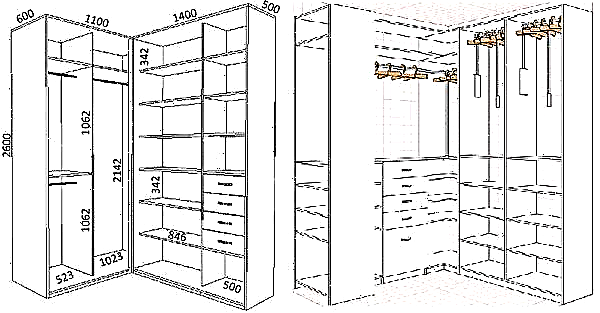
DIY dressing room
See different dressing options:
Do-it-yourself shelves and doors
Doors
- You can choose any doors, but the best option would be to use sliding doors or accordion doors. This will save space.
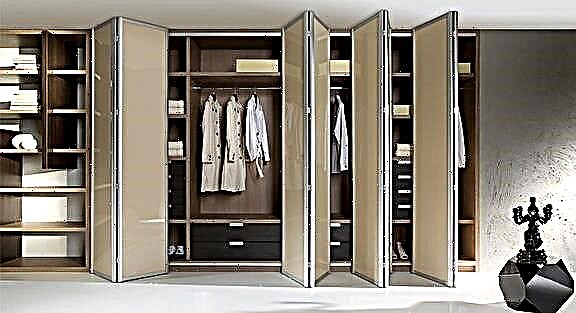
Harmonica door in the dressing room
- This type of door can be installed in both square, rectangular, and corner wardrobes. They can be wooden, glass, plastic, fabric, louvre and even mirror, it's all a matter of taste and family budget.
Shelves
- Shelves and racks can do it yourself or order in a furniture store. The traditional set includes rods with shoulders, hooks, laundry baskets, closed drawers, various shelves for clothes and shoes, shelving.
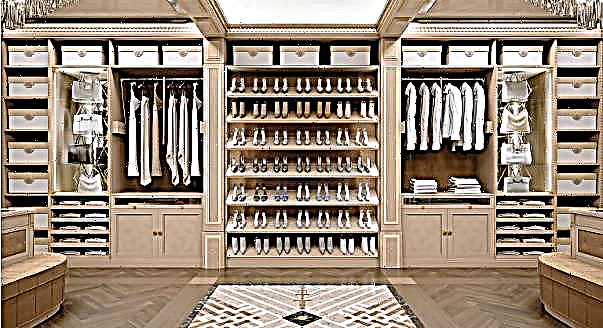
Wardrobe Shelf Options
Cheaper, of course, is to do it yourself, to do this, make shelves of metal mesh. Better use welded fine mesh. It is produced in chrome, galvanized, with PVC coating. Such scraps can be purchased very cheaply in the store, because they are no longer suitable for sale, and just right for shelves.
- IN small dressing room it is best to make more open shelves and a few drawers. The most optimal shelf locations are the “letter G” and the “letter P”.
- Racks conditionally divide into zones. For example, lower, middle and upper. Bottom is better to place shoes, knitwear, underwear. In the middle zone, place your casual clothes (pants, skirts, dresses, bags). Above it is most convenient to store things that are rarely used, for example, seasonal clothes.
How to equip a dressing room with your own hands
- When arranging a dressing room, do not forget that there is no natural light. The most popular today LED lightening. Also widely used spot lighting, built-in lamps.
- Large chandelier It will also be a good solution to the problem.
- Can do shelf lightingwhich is very convenient on the lower shelves with shoes.
- To conveniently place things, buy different hangers, brackets and hooks.
- Very comfortable are two-level dressing roomsas well as designs with turnstiles.
- If the apartment is very small, then you can use as a dressing room storage room, niche, balcony. They can be equipped with narrow racks, racks to the ceiling, mobile hangers.

Wardrobe from the pantry
- Can be fixed to walls metal or wooden rods, on which clothes will be hung.
- From below do shelves for storing shoes. It is important to consider that they do not interfere with the free movement of the wardrobe.
- Do not forget about ventilation, since things have a peculiarity to lie down, while acquiring not the most pleasant aroma. Ventilate clothes periodically on the balcony.
- Hang in the dressing room special sachet with your favorite smell.
- Can hang a mirror it will not only be a convenient part of the interior, but also allow you to visually increase the space of the room. For greater comfort, you can attach a backlight to it.
DIY Japanese curtains: step by step instructions
Wardrobe storage system
Everyone chooses their own convenient storage system, but still, given the shortcomings of many owners of wardrobes, I want to give some advice.
- Make room for seasonal clothing. It can even be a separate shelf on top.
- Hang the trousers separately.
- Use a separate shoe storage compartment.
- For each family member, make three or more drawers.
- Install 2 pipes, hang long things on hangers on one and short things on the other.
- Things that do not crumple can be laid out on open shelves.
- Take care of accessory compartments - ties, belts, jewelry. To do this, you can use small drawers.
- Bags are best stored on hooks or on separate shelves.
- It is very convenient to use a basket for dirty laundry, which will save space in the bathroom.
In conclusion, I want to note that everything is not as complicated as it seems at first glance. In addition, it is first and foremost a guarantee of reliable and durable storage of things, a guarantor of protecting clothes from fading and moths. A dressing room is a fully realized and affordable dream.
Video on how to make a dressing room with your own hands:


